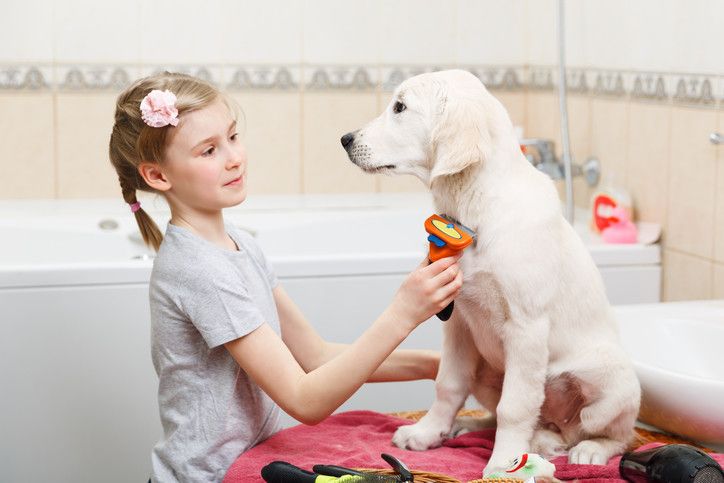There are many factors that we have to consider about different breeds before getting a puppy, and one of the common warnings issued about Labradors is that they will leave hair everywhere.
Do Labradors shed a lot?
This guide will look at the coats of labradors and what owners can expect from Labrador Retriever shedding before discussing issues such as grooming, bathing and dietary changes.
Table of Contents
Yellow or black?
When trying to find out whether Labrador Retrievers shed a lot, many owners will specifically ask about their yellow Labrador.
At times it can seem like these dogs shed more because the hair shows up so much – such as against your dark sofa or work suit – but the truth is that all Labradors shed equally.
Black Labradors will make just as much of a mess and it is something that all new dog owners need to consider. The reason for this is that all labs have a double coat. This means there is a glossy outer layer for waterproofing and also an insulating undercoat – twice as much to lose.
It all stems from evolution. These dogs where bred for hunting and retrieving in cold lakes and many still shed in seasonal moults in the spring and fall.
The best approach for managing Labrador Retriever shedding is to groom them regularly
Grooming a Labrador can be tough and time consuming but it is often necessary if you want to keep the problem under control.
Under normal situations, a weekly grooming session with a suitable brush should be enough to ensure that you don’t have mountains of shed hair to deal with.
During the moult, however, this can increase to one a day with the amount of hair that these dogs can use. Essentially, you can commit yourself to one of two things as a Labrador owner: either vigorous, arm-aching brushing to remove the hair in one go, or continuous vacuuming to remove it all from the carpet and sofa.
Is there a best brush for a Labrador retriever?
The answer to this will vary from owner to owner as we all have our different views on the best tools and approaches. A basic brush may not be enough for a lab in a heavy moult, which means that tougher, more specialised tools may be needed. There are simply rubber contraptions that attract the hair for simple removal and stimulate oil production through massage.
Alternatively, you could used something like the Furminator for a tougher approach to stripping out the dead layer of undercoat. The latter is effective, but you do have to be careful not to damage the coat and make sure that the dog is happy to be groomed this way.
The issue of bathing and shaving labs.
Some Labrador owners may ask an important follow up question here: can you shave a lab? To some first time owners, shaving may seem like the ideal solution as it cuts down the hair entirely and makes the coat much more manageable.
The problem with this approach is that it doesn’t take the welfare of the animal into consideration.
Labs need their coats for protection against the sun and heat control and shaving denies them this right. Therefore, all dog owners are urged to never resort to shaving a Labrador to reduce shedding.
Bathing dogs is another option that many pet owners turn to when shedding becomes a problem but how often should you bathe a Labrador? There are different approaches to the subject and it ultimately depends on how much care and attention you give to your dog.
A regular bath, with the right treatment, can help with Labrador Retriever shedding and make the problem more manageable, but excessive treatment could be damaging. Be sure to use a dog-friendly shampoo that is suitable for the coats of Labradors and try a little gentle massage to loosen the hairs.
Other Labrador Retriever shedding solutions
There are other considerations to make when dealing with the problem of lab shedding.
Because the moult is related to the seasons and the temperature of the house, owners often notice that dogs that are kennelled often shed in this seasonal pattern while those that are inside shed more continuously.
It is also worth checking your dog for fleas, as scratching more cause more hair to fall out, and also to consider their diet.
The latter could be particularly useful if your Labrador’s shedding seems to have become more excessive.
Dealing with excessive Labrador Retriever shedding
The heavy shedding of a lab coat is usually to be expected with the breed, but there may be times when you feel that they are losing much more hair than normal.
If this is the case, the best course of action is to take your dog to the vet to get them checked for hormonal imbalances, allergies, thyroid conditions, stress or other medical conditions. Some medication or a simple change of diet could make all the difference.
What is the best dog food for shedding labs?
Many owners ask whether there is a simple type of dog food they can buy to help with black lab shedding but the solution normally comes down to the nutritional advice of your vet.
By pinpointing deficiencies in vitamins, minerals and other elements, they can put your dog on a much better diet. Often this will mean an increase in fatty acids as these oils are responsible for the health of the skin and coat of Labradors.
Omega-3 dietary supplements can also be helpful, but again it is best to consult a vet before giving them to your pet.
Summary: dealing with shedding Labradors is time consuming but worthwhile
The simple answer to question of do labs shed is yes, they will shed a lot of fur and you will be constantly dealing with it or cleaning it up.
There is no magic wand to wave to make it go away and you have to be committed to grooming and bathing your pet during the seasonal Labrador Retriever shedding moults.
There are tools that can help, such as better brush and an enhanced diet, but, in the end, the best tool you can rely on is your pet hair vacuum. Give in to the pros and cons of Labrador ownership and remember how much you love your pet, no matter how much they shed.

